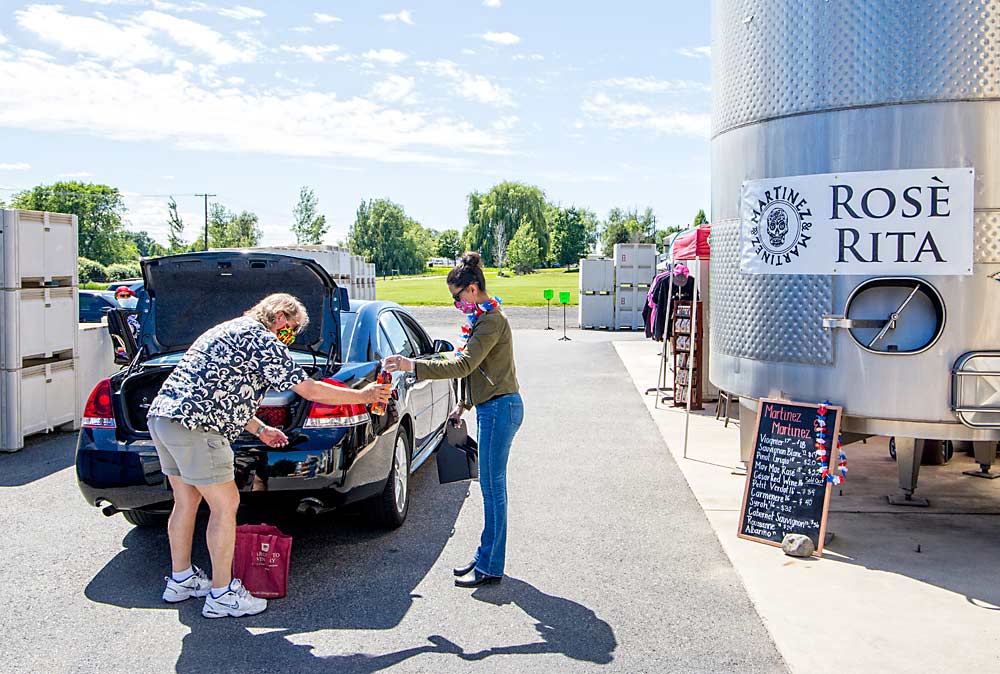
Drive-through pickups, online orders, club shipments.
Wine might not be essential in the strictest sense, but people are still drinking plenty of it during this pandemic, and wineries are going to great lengths to get their products to customers in 2020.
The challenge for the U.S. wine industry is that COVID-19 dramatically shifted where consumers bought their wine, swapping grocery delivery or shipments for the usual sipping in restaurants and tasting rooms. Travel to wine country vanished.
“It’s a huge retraction in the amount of wine all of us are used to moving,” said Phil Cline, owner of Naches Heights Vineyards in Washington, in May. “There’s so much uncertainty.”
The uncertainty continued into the growing season: When tasting rooms and restaurant patios reopened at limited capacity in the summer, customers were eager to return, but the lost months — and a future with lost events and lost capacity — mean many wineries are looking to cut back.
Growers will feel the impact at harvest.
“Many growers are struggling to find buyers for their fruit,” said John Aguirre, president of the California Association of Winegrape Growers. “Wineries want to renegotiate prices, delay payment or not renew contracts. It’s pretty clear wine grape growers will be affected.”
Despite this, Aguirre said, the organization couldn’t get growers qualified for federal relief provided to other agricultural producers in the $16 billion Coronavirus Food Assistance Program Congress passed in April.
The pandemic will cost California wine grape growers at least $437 million in lost sales from this year’s harvest, an 11 percent decline in crop value, according to an impact assessment the industry’s trade association conducted. The assessment puts the overall loss to the California wine industry at $3.6 billion over 12 months. While supermarket and liquor store sales increased 10 percent, sales in tasting rooms and restaurants were forecast to be down 60 percent over the year.
In Washington, the growers’ association also hired economists to assess the impact of the pandemic, but it was still in progress in August when this issue went to print.
“We definitely need some type of relief package,” said Shane Collins, chair of the Washington Winegrowers Association’s board. At Rocky Pond Winery in Chelan, where he serves as both the director of viticulture and winemaking, wine sales were booming in July with tastings open at limited capacity, but the vineyard’s contracts with other wineries were delayed and down.
“People are taking less fruit; they didn’t move much besides wine club members this spring,” Collins said of his clients who cut back their contracts, ranging from 5 to 50 percent. “They anticipate having wine they would have sold this year carry into next year.”
With the unsold grapes, he plans to experiment in his own winery and look for opportunity in the bulk wine market.
“We farm it like we are still going to make a deal on it up until we pick it,” Collins said. “It’s hard to walk away from it when you’re invested.”
Smaller wineries that sell directly to consumers from their tasting rooms or supply local restaurants — which have been the bright spot in Washington’s wine industry in recent years — were hit the hardest because they didn’t have other supply channels to pivot product into.
“Wineries that are big enough to have distributors, they are not feeling it as bad as wineries that are relying on walk-in customers and wine club members,” said Mark Tudor, a Yakima Valley grower.
One of his clients, the Martinez and Martinez Winery — owned by his daughter and son-in-law — turned to weekly drive-through hours during the shutdown so customers could pick up orders without leaving their cars. They offered shipping discounts and partnered with a local caterer for wine pairing dinners too, said co-owner Monica Martinez.
“We’ve been able to generate a little cash flow, but thoughts about the rest of the year are pretty dire with a prolonged shutdown,” she said. Midsummer, she was still debating taking their regular crop or cutting back.
“When the shutdown first happened, it was really scary and dire, so I canceled a bottling order,” she said. Now, they are sold out of one of their most popular reds. “When things open up, we want to have the wines available to sell.”
Relief?
In July, California’s congressional delegation sent a letter to the U.S. Department of Agriculture seeking to have wine grape growers added to the list of producers eligible for direct payments under the pandemic response program Congress passed in April. The program initially offered direct payments only to growers who could demonstrate market loss or price loss from January to April of 2020. That left grapes, California’s most valuable crop at $6.25 billion, out.
“It’s incumbent on Congress to make sure future programs are inclusive of wine grape growers and other commodity sectors that weren’t deemed eligible” in the first round of aid, Aguirre said. “The impact of COVID-19 makes the existing supply issues a lot worse.”
The pandemic hit as both California and Washington’s wine industries faced oversupply due to flattened growth in consumption, pushing down prices and stranding some growers without contract renewals.
Growers have experience weathering the industry’s demand cycles, Aguirre said.
“But when you have the sudden shutdown of market channels, that’s not something a grower can prepare for,” Aguirre said. “We need assistance. These are government-imposed shutdowns of markets and we are going to argue strongly for aid.” •
—by Kate Prengaman







Leave A Comment